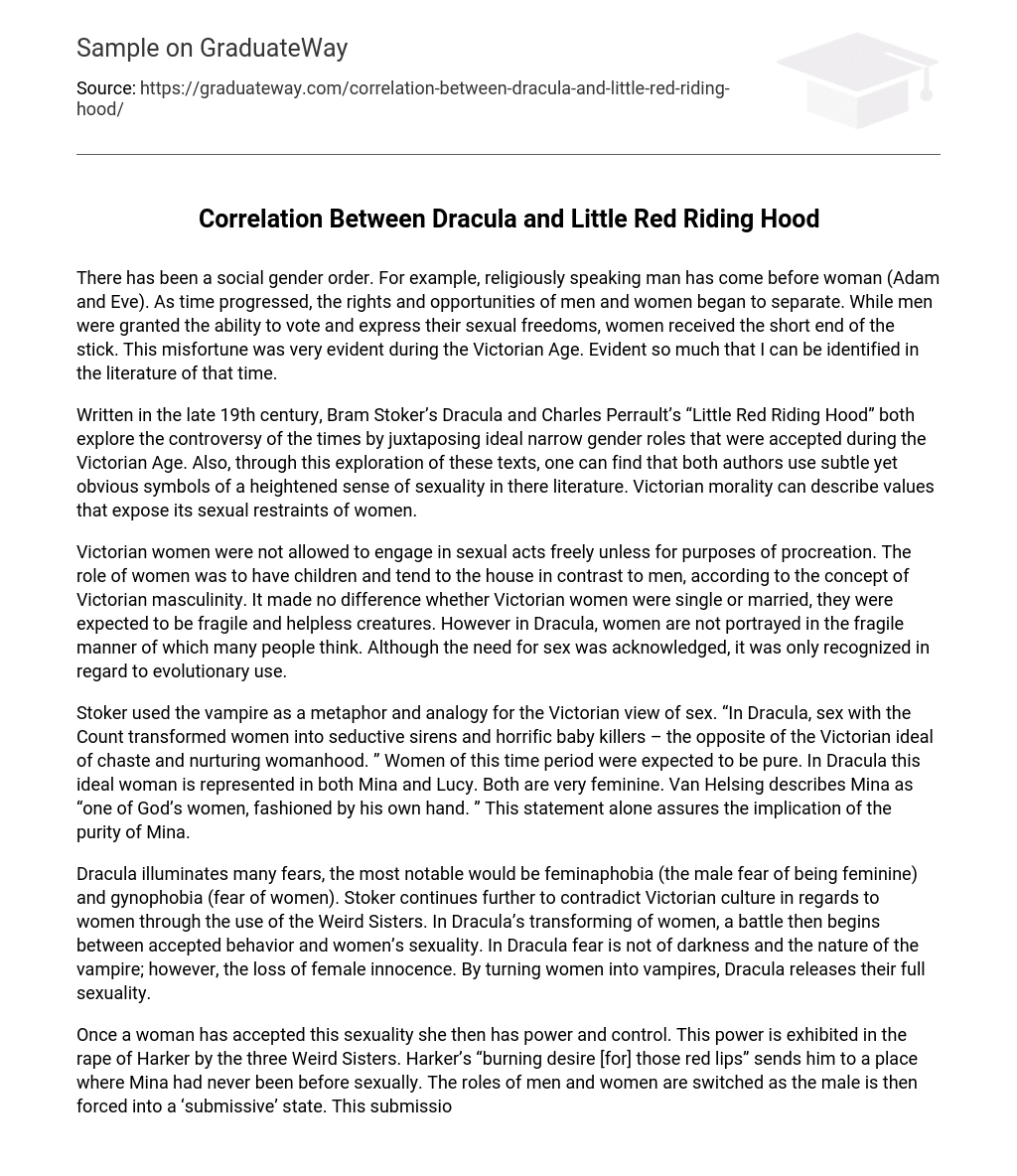In the course of history, a hierarchical structure based on gender has prevailed, favoring men over women. This can be observed in religious stories like the tale of Adam and Eve. As time progressed, the rights and opportunities afforded to men and women became more divergent. Men were bestowed with advantages such as suffrage and sexual autonomy, while women encountered disadvantages. This disparity was especially evident during the Victorian era, permeating its literary works.
Both Bram Stoker’s Dracula and Charles Perrault’s “Little Red Riding Hood” were written in the late 19th century and delve into the controversy of the Victorian Age by contrasting accepted narrow gender roles. Moreover, these texts also contain subtle yet noticeable symbols that reflect an intensified awareness of sexuality. It can be said that the values of Victorian morality exposed the sexual limitations imposed on women.
In Victorian society, women were restricted from freely participating in sexual activities unless they were for the purpose of procreation. Their main role was to bear children and attend to domestic responsibilities, which contrasted with the expectations for men under the concept of Victorian masculinity. Whether single or married, Victorian women were expected to be delicate and dependent beings. However, the portrayal of women in Dracula challenges the common perception of their fragility. While the importance of sexual desires was acknowledged, it was only considered within the context of evolutionary necessity.
Stoker utilized the vampire as a symbol and comparison for the Victorian perception of sexuality. “Dracula portrays women who engage in sexual acts with the Count as becoming alluring temptresses and abhorrent murderers of infants – which directly opposes the Victorian standard of modest and nurturing femininity.” During the Victorian era, women were expected to adhere to a notion of purity. In Dracula, this virtuous woman is exemplified by Mina and Lucy, both embodying strong feminine qualities. Van Helsing praises Mina as “one of God’s women, fashioned by his own hand,” affirming her innocence and virtue.
Dracula explores various fears, including feminaphobia and gynophobia. The novel challenges Victorian societal norms regarding women by introducing the characters of the Weird Sisters. This transformation of women in Dracula leads to a conflict between societal expectations and female sexuality. Unlike traditional vampire stories, Dracula’s primary concern is not darkness or the nature of vampires, but rather the corruption of female innocence. Through the transformation into vampires, Dracula unleashes women’s untamed sexuality.
Once a woman embraces her sexuality, she gains power and control, as seen in the rape of Harker by the three Weird Sisters. Harker’s intense desire for their “red lips” takes him to a sexual realm unknown to Mina. This incident reverses the typical roles of men and women, with the male being forced into a submissive position. This is significant because it challenges the Victorian belief that men should always be rational and in control. Another instance of heightened female sexuality can be observed in Lucy’s transformation.
Lucy undergoes a transformation after being bitten by Dracula, becoming a seductive figure who desires Arthur. In Charles Perrault’s rendition of “Little Red Riding Hood,” the theme of sexuality is also present. The story adheres to Victorian ideals by cautioning women against engaging with men who have ulterior motives. This version of “Little Red Riding Hood” has been interpreted as a tale of sexual ethics.
Throughout the short story, there are indications of sexuality. For instance, Perrault portrays the grandmother’s devouring with suggestiveness, stating that the wolf “threw himself on the good woman.” Moreover, prior to consuming the young girl, he invites her to bed. Upon doing so, she “took off her clothes and went to lie down in the bed.” Following a detailed examination and commentary on various aspects of the wolf’s “big” body parts, the wolf proceeds to “throw himself upon Little Red Riding Hood” in order to devour her as well.
According to many critics, this story delves into the theme of discovering one’s sexuality and imparts important lessons for both boys and girls. The way Perrault presents the antagonist, the wolf, is notable for its human-like traits. The wolf represents manipulative and deceitful men. It serves as a cautionary tale for women about the potential peril of inviting such individuals into their lives. The story advises young girls (and educated women) to exercise caution and remain vigilant since looks can be deceiving. Despite their charm and kindness, wolves may assume different disguises.
Living as a woman in the Victorian Era entailed fulfilling the duty of engaging in sexual relations solely for the purpose of procreation, while any enjoyment was strictly forbidden. The notion of sex was completely disregarded by respectable and cultured women. Prostitution flourished to fulfill men’s desires, since it was deemed inappropriate for married couples to engage in intercourse unless their intention was to conceive. Ultimately, both Dracula and Little Red Riding Hood emphasize the importance and influence of sexuality.
Although categorized as a fairy tale, Little Red Riding Hood incorporates various symbols with sexual connotations. Throughout centuries, the story has been acknowledged for its implicit sexuality, yet it persists in being cherished and handed down through generations. The narrative communicates the notion that women should be inherently subservient; otherwise, disorder will ensue since they are anticipated to depend on their spouses. Even today, certain segments of society restrict female sexuality within specific limits. Nevertheless, the advancements made by women in attaining liberation and embracing their own sexuality are embraced.





